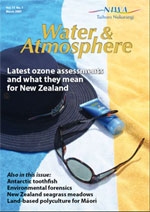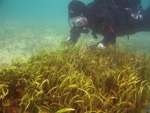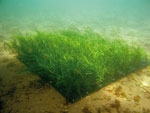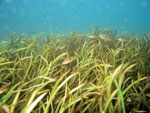PDF of this article (132 KB)




Raised and educated in Auckland, Matt Smith has parlayed his love of the outdoors into a job that features lots of fieldwork and some unusual diving opportunities. These days his work at NIWA in Auckland encompasses fisheries research, marine ecology, and biosecurity.
Were you always interested in science?
I wasn’t one of those kids who decide to be a scientist at year dot. I’ve always been keen on understanding how things work and spent most of my younger days pulling things apart and rebuilding them (still do). Then, in sixth form at Rangitoto College, I took biology and the light bulb began to glow. Here was a topic with so much incredible stuff to learn – and it literally surrounds us every day. It seemed silly NOT to attempt to understand all this.
Around this time I began diving, doing a PADI (Professional Association of Diving Instructors) Open Water course for certification. A few of the biology papers branched out into marine areas, with options for field work at Leigh Marine Laboratory at Goat Island, a marine reserve north of Auckland.
That was it! I knew this was to be my career. I switched to a BSc, even though this added a year to my undergraduate degree, and I’ve never looked back. I worked summers as a volunteer assistant at Leigh – diving constantly and helping out with snapper and gurnard physiology experiments, and as a boat ramp interviewer for MAF. Eventually I graduated with an MSc (Hons) degree in marine ecology and aquaculture. I also completed PADI Advanced and Rescue diver qualifications.
What did you study at university?
My first career choice was journalism, so at Auckland University I got stuck into a BA degree, majoring in English literature with biology and physical geography as additional ‘side’ papers.
How did you come to work at NIWA?
After my big OE in Europe and the UK, I managed to get a foot in the door at NIWA and began work on snapper, collecting stock size and age information for stock assessments.
What do you like best about your job?
I’m part of the Fisheries and Marine Ecology team. We work on stock assessments for various fin and shellfish, and on fish ecology in harbours, estuaries, and offshore island reefs. I enjoy hands-on work in the field, although roughly half my work is office or laboratory-based.
My favourite part of the job has to be when we embark on a field expedition that’s been months in the making. There’s usually tonnes of gear and equipment, lots of staff who have reunited from around the country, and a general feeling of ‘what the heck have we got ourselves in for!’ We set up camp in a strange place and then spend 12–hour days for a week or two, all for the sake of science. At the end of it, even though you’re usually exhausted, you realise you’ve seen something or been somewhere that very few people will ever get to experience – and that without this job you probably wouldn’t have dared to go there!
What’s an ASU?
Through Mark Morrison’s seagrass project (see ‘Comparing seagrass meadows across New Zealand’), I’ve spent a fair amount time underwater looking at this type of habitat. We’re interested to see if seagrass enhances population growth and, conversely, if loss of this habitat reduces growth. It’s difficult to experimentally manipulate natural seagrass beds, so we created some artificial seagrass units, or ASUs.
Mark, Crispin Middleton, and I constructed artificial seagrass from plastic plants, mesh, and reinforcing grids. Last December, we put our ASUs into the subtidal areas of Whangapoua Estuary, Coromandel, where very little natural seagrass remains. Our first ‘harvest’ in late January revealed many small fishes hanging around in the ASUs, including spotties, juvenile snapper, leatherjackets, clingfish, and triplefins. The ASUs are hot real estate for these very recently settled fish.
You’re also involved in marine biosecurity?
Around five years ago, I was asked to help verify the rumoured arrival of the Japanese paddle crab (Charybdis japonica) in Waitemata Harbour. We set some traps and when we hauled them in they were filled with Japanese paddle crabs fighting each other. Great that we had captured this invader, but bad for New Zealand’s biosecurity! From there I got involved in baseline port surveys and surveillances, travelling around the country documenting what organisms are where, and what shouldn’t be there.
Recently I’ve helped survey international yachts for fouling organisms. We dive under the boats when they’re at a marina clearing customs, shoot video and photographs, and take samples from the hull. These samples are then identified by taxonomic specialists.
As one of NIWA’s Regional Dive Safety Officers, would you say it’s all work and no play?
Scientific diving is more of a tool of the trade than a recreational sport. A lot of it is in low visibility and can be in places you wouldn’t normally want to dive, like around piles and wharfs in major ports. But it can also be great: sponge collecting in the Cook Islands, underwater video surveys of the Poor Knights Islands, or seagrass surveys on Farewell Spit.
Either way, we always have a job to do when we’re underwater, and the emphasis is on safety first. NIWA trains its divers very thoroughly. That includes a gruelling week-long Scientific Divers ‘boot camp’ to become an OSH-qualified diver, with mixed gas, river, deep diving, night, navigation, and search and recovery endorsements. We have yearly refresher training and specialty courses like ice diving as needed.
